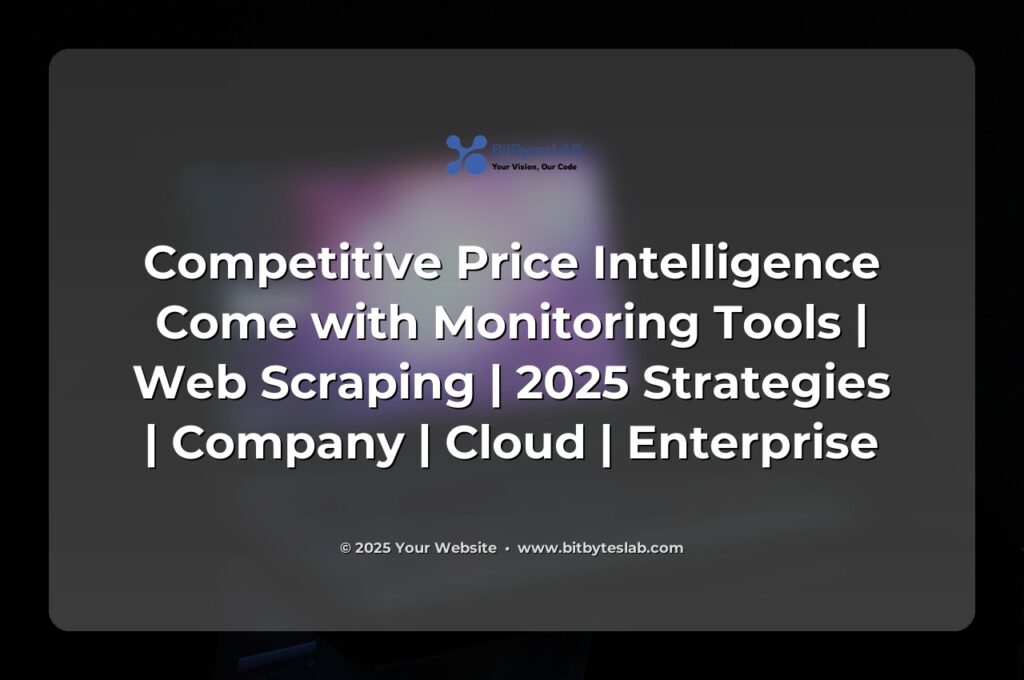🎯 In a world where a single price tweak can shift market share like a tidal wave, competitive price intelligence (CPI) has moved from a nice‑to‑have to a must‑have in 2025. Think of it as the GPS for your pricing strategy, constantly charting the fastest, most profitable route through crowded e‑commerce seas.
🚀 If you’re still waiting for a “seasonal sale” to cast a shadow on your margins, you’re missing out. Retailers who harness CPI are not only reacting to price changes but anticipating them, adjusting inventory, and fine‑tuning promotions before the next competitor hits the market.
Problem Identification and Context
Most companies still rely on spreadsheets or manual price monitoring—a recipe for stale data, blind spots, and missed opportunities. In 2025, approximately 68 % of retailers that do not automate CPI risk falling behind within the first two years of a major price shift. The temptation is to use APIs, but when they’re incomplete or locked behind paywalls, the only viable option is web scraping. Yet scraping is often seen as a hard, legally fraught, and maintenance‑heavy exercise.
Core Concepts and Methodologies
At its heart, CPI blends four pillars: continuous data collection, intelligent extraction, real‑time processing, and actionable insight delivery. A modern stack is cloud‑native, uses AI to parse dynamic pages, and includes observability to keep every node healthy. Think of it as a high‑speed data pipeline that turns raw HTML into clean, trend‑ready tables within minutes.
Key components include: headless browsers for rendering JavaScript‑heavy sites, proxy rotation to evade bans, a data lake for raw and processed data, event‑driven pipelines that fire alerts on a price drop, and AI/ML models that spot synonyms, dedupe SKUs, and infer missing currency data.
And let’s not forget governance: robots.txt compliance, GDPR and CCPA‑friendly data handling, and role‑based access to sensitive pricing feeds.
🔧 Why do Java developers wear glasses? Because they can’t C# 👓

Expert Strategies and Approaches
First, start with a clear KPI set: margin lift, price elasticity, or share of voice. Then build a modular scraper that separates collection, extraction, normalisation, and loading. This keeps each layer testable and allows you to swap in better AI models without rewriting everything.
Use asynchronous I/O and headless browsers to maximise concurrency—ten or twenty parallel Chrome instances can fetch thousands of pages each minute. Pair that with a robust proxy pool that includes residential IPs and geo‑targeting to mimic legitimate traffic.
For extraction, machine‑learning models trained on labelled price cards can outpace CSS selectors when sites change layout. Combine that with visual scraping (OCR and computer vision) for pages that serve prices as images—common on premium fashion sites.
Observability is non‑negotiable. Metrics like success rate, latency, and IP‑block frequency should hit a dashboard in real time. A single 5‑minute spike in errors should trigger alerts so you can pivot your crawl strategy before a competitor gains an edge.
Industry Insights and Trends
According to recent research, 78 % of retailers that adopted AI‑driven extraction saw a 12‑15 % improvement in data accuracy, while those using serverless functions cut operational costs by 30 %. GraphQL APIs are now a staple for e‑commerce back‑ends, enabling precise queries that reduce payload size by up to 60 %.
Edge computing is also on the rise. Running scrapers on Cloudflare Workers or AWS Lambda@Edge brings you closer to target servers, slashing latency and further evading geofencing. Meanwhile, privacy‑first crawling—processing data locally and only sending aggregated insights—helps satisfy GDPR and CCPA without compromising granularity.
⚡ A SQL query goes into a bar, walks up to two tables and asks… ‘Can I join you?’ 🍺

Business Applications and ROI
Competitive price intelligence isn’t just about reacting; it’s about predicting. Dynamic pricing engines receive real‑time feeds and adjust prices within 5–15 minutes, unlocking a 5 % uplift in margin for high‑volume categories. Inventory planners who align stock levels with price trends can reduce overstocks by up to 20 % and cut carrying costs.
Marketing teams use CPI to time promotions, ensuring they hit the sweet spot when competitors are off‑price. Brand protection squads monitor unauthorized listings, flagging counterfeit prices before they erode customer trust.
Common Challenges and Expert Solutions
IP blocking and CAPTCHAs still bite most scrapers. The solution? Residential proxy pools, realistic user‑agent rotation, and adaptive back‑off algorithms that pause during peak times. For dynamic content, headless browsers with auto‑retry and network‑idle detection reliably render the final price.
Data quality nightmares—missing SKUs, currency mismatches, or duplicated entries—are tackled with a normalization layer that enforces ISO 4217 conversions and SKU fingerprinting. A smart dedupe engine uses fuzzy matching to merge near‑identical product records.
Scalability and cost are addressed by serverless functions that spin up on demand. Spot instances or pre‑emptible VMs handle batch runs during off‑peak hours, keeping bills under control while still delivering the depth of coverage needed for enterprise decisions.
Future Trends and Opportunities
In 2026, we expect AI to move from extraction to inference—models that predict competitor price changes before they happen. Edge AI will allow on‑device inference for even faster reaction times, while hybrid cloud setups keep data residency compliant across regions.
Real‑time dashboards powered by WebSocket streams will let decision makers see price shifts live, and automated alert systems will begin to recommend optimal price moves rather than just reporting changes. The combination of CPI with demand forecasting models will enable hyper‑personalised pricing at scale.
Conclusion
Competitive price intelligence is no longer optional; it’s the engine that drives profitable growth in a hyper‑competitive marketplace. By marrying cloud‑native architecture, AI‑driven extraction, and robust observability, enterprises can transform raw price data into actionable strategy—quickly and reliably. If you’re ready to make CPI work for you, let BitBytesLab help you build a resilient, compliant, and future‑ready CPI platform.

